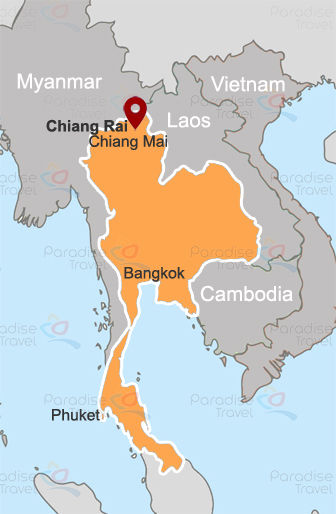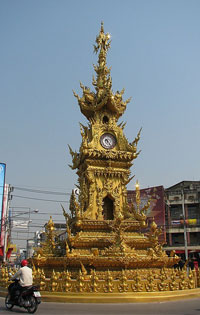Chiang Rai Travel Guide
 Situated on the Kok River basin, Chiang Rai is the most northern province of Thailand. The province covers an area of approximately 11,678 square kilometers with an average altitude of 580 meters above sea level and a population of 1.23 million. The provincial capital is 820 kilometers north of Bangkok and 182 kilometers from Chiang Mai. Chiang Rai reaches the Mekong River to the north and is bordering Myanmar on the North and Laos on the north and northeast.
Situated on the Kok River basin, Chiang Rai is the most northern province of Thailand. The province covers an area of approximately 11,678 square kilometers with an average altitude of 580 meters above sea level and a population of 1.23 million. The provincial capital is 820 kilometers north of Bangkok and 182 kilometers from Chiang Mai. Chiang Rai reaches the Mekong River to the north and is bordering Myanmar on the North and Laos on the north and northeast.
The province is located within the notorious Golden Triangle area in Amphoe Chiang Saen where Myanmar, Laos and Thailand converge; it was once the centre of the opium and heroin production. The Thai region of the former triangle is full of small quiet hill tribes. Chiang Rai was founded in 1262 A.D. by King Mengrai (or Mangrai) as the capital of the Lanna Thai Kingdom for around 30 years; the area was later conquered by Burma in 1558. It was not until 1786 when Chiang Rai became part of the Thai kingdom again. It was proclaimed a Thai province in 1910 during the time in power of King Rama VI.
Chiang Rai is an excellent alternative to Chiang Mai. The area is gifted with wonderful natural tourist attractions: magnificent mountain sceneries covered by forests, remarkable rivers, botanical gardens, caves, waterfalls. Trekking, Elephant Riding and Rafting are highly recommended here. Natural attractions include the powerful Mekong River, Doi Tung (“Flag Mountain”), Doi Mae Salong Mountain (including its nearby tea plantation), Pu Kaeng Waterfall, Buffalo Horn Hill, Khun Kon Waterfall, Nam Khun Kon Forest Park and more.
The province is also home to several ethnic tribes including Yao, the Akha, Lisu, Lahu, Lahu Shi, Karen, Blue Maeo, and White Maeo. Each group maintains its fascinating ways of life. The province is a traveler’s heaven, rich in tourism resources, attractions range from ruins of antique settlements, historic spots, Buddhist shrines and more. These places to visit include:
The Chiang Saen National Museum holds antique Buddha images and other relics. The Hall of Opium in Chiang Saen Museum houses exhibits showing the impact of opium in the society. Phra Tamnak Doi Tung, a royal residence for the Princess Mother, adjacent to the residence is the Suan Mae Fah Luang, a beautiful botanical garden.
Wat Phra Kaew, a Buddhist temple, famous for have been once the home of the Emerald Buddha, the most famous Buddha image in Thailand, now a replica made from green jade in celebration of the Princess Mother’s ninetieth birthday is housed on site. Wat Phra Kaew houses also a 700-year Buddha image.

Wat Phra Sing, located on Singhakhlai Road, this Wat once housed the Pra Singh or Pra Buddhasihing, an important Theravada Buddha image, which is now located in Chiang Mai. Inside are several replicas of this image. The Wat Phra That Doi Tung is a very important temple for the Buddhist; the Wat is atop the highest Chiang Rai Mountain at Doi Tung, probably the most fantastic view of all temples in Thailand, the location is where King Mengrai chose the site for his new Lanna capital, the temple is a most important place of worship for Buddhists from as far as Laos and Myanmar.
Chiang Rai can be easily reached by plane, through the Chiang Rai International Airport or by bus. Chiang Rai also serves as a tourism entry into Myanmar and Laos.
